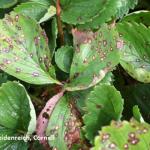Strawberry IPM —Common Foliar Diseases
A number of fungi cause foliar diseases on strawberry. There are subtle differences among these diseases, but they also have a few things in common. All of them overwinter in infected leaves and crop debris. All produce spores in spring and early summer, and the spores are spread primarily by splashing water. Spores are produced in wet conditions. All require long periods of leaf wetness (12-18 hours or more) at optimum temperatures for spore germination and infection to occur. Proper site selection, removal of crop debris, improvement of air circulation through proper spacing and removal of weeds, renovation/renewal, and the use of drip irrigation (as opposed to overhead watering) are all appropriate cultural methods for foliar disease control. Spring nitrogen fertilization can encourage excess leaf growth resulting in poor air circulation and longer drying time in the plant canopy. This can lead to higher incidence of foliar diseases. Therefore, nitrogen fertilizer should be used sparingly prior to harvest and is more effectively used as a split application, one at renovation time and one in early fall to support flower bud formation for the following year.
Leaf Spot (Mycosphaerella fragariae)
Leaf spot is one of the most common diseases of strawberry. Lesions begin as small, roundish, reddish-brown or purple spots on the upper leaf surface. As they mature, spots turn light brown or gray in the center, but retain a purple margin. Spots may also appear on the lower surfaces of leaves as the infection progresses. The black, round, spore-producing structures (fruiting bodies) of Mycosphaerella appear in the centers of the lesions and may be visible with a hand lens. The leaf spots expand to a size of 3-6 mm, and may coalesce to form larger areas of necrotic tissue. A severe infestation will kill leaves. Spots may also appear on other aerial parts of strawberry plants. Fruit infection is not common, but can appear on mature and immature fruit as small, sunken, black spots. Leaf spot can occur at temperatures between 50 and 90°F, but is most prevalent at 59-77°F. Symptoms can vary somewhat in appearance depending on the weather.
In addition to overwintering in crop debris, Mycosphaerella overwinters in the soil as small, hard resting structures called sclerotia. The severity of an infection is dependent upon the weather, the strain of the fungus, and the strawberry cultivar. Cultural practices and fungicide applications made to control fruit rots or other strawberry disease problems often help suppress leaf spot as well. In addition, many tolerant and resistant cultivars are now available. The June-bearing varieties Allstar, Earliglow, and Jewell are considered resistant to both leaf spot and scorch, while Honeoye is considered tolerant. These varieties generally perform well in New England. Refer to the New England Small Fruit Management Guide for currently recommended fungicides and an updated list of resistant cultivars.
Leaf Blight (Phomopsis obscurans)
Leaf blight closely resembles leaf spot. Lesions begin as small roundish, reddish-brown or purple spots that turn light brown or gray in the center as they mature, but retain a purple margin. The small, black fruiting bodies of Phomopsis appear in the centers of the lesions and may be visible with a hand lens. These are similar to those produced by Mycosphaerella, but the fruiting bodies of Phomopsis have distinctive protruding necks, and in wet weather, light-colored coils or masses of spores can sometimes be seen emerging from them. As the disease progresses, V-shaped areas of necrosis occur, often with reddish borders. Stems may also be infected. Lesions on ripening fruit may begin as soft pink spots which later become dry and brown. Temperatures 79-90°F are optimum for disease development.
Leaf blight can destroy older foliage later in the growing season and may weaken plants, resulting in reduced yields the following year. Cultural practices and fungicide applications made to control fruit rots or other strawberry disease problems often help suppress leaf blight as well. There are no resistant cultivars available, but some are believed to be more tolerant of leaf blight than others. Refer to the New England Small Fruit Management Guide for currently recommended fungicide materials.
Leaf Scorch (Diplocarpon earlianum)
Leaf scorch causes reddish purple lesions 1-5 mm in diameter on the upper leaf surface. All aerial parts of the strawberry plant can be infected. Unlike those caused by leaf blotch and leaf blight, the lesions do not change color in the center. Large areas of the leaves may turn red or yellow and then brown, and leaf margins curl upward. These areas are generally not V-shaped as they are in leaf blight. Disease development is favored by wet weather and temperatures 59-77°F; however, disease can continue to progress at temperatures ranging from 32 to 95°F. Severe disease is usually more common in late summer and fall, and more prevalent on older leaves. The small, dark fruiting bodies of the fungus may be visible with a hand lens.
Scorch can seriously weaken plants, compromising their ability to resist drought stress and winter damage. Cultural practices and fungicide applications made to control fruit rots or other strawberry disease problems often help suppress leaf scorch as well. Resistant cultivars are listed above under leaf spot. Refer to the New England Small Fruit Management Guide for currently recommended fungicides and an updated list of resistant cultivars.
Other types of Foliar Disease
Some other fungi cause foliar disease on strawberry as well as those described above. Bacteria and viruses may also cause foliar disease. Proper diagnosis is crucial to the success of any disease management program. For information on sending samples to the UMass Extension Plant Diagnostic Laboratory, please go to http://ag.umass.edu/services/plant-diagnostics-laboratory.
This work was supported by the Crop Protection and Pest Management Extension Implementation Program, Grant No. 2014-70006-22579 from the USDA-National Institute of Food and Agriculture.


